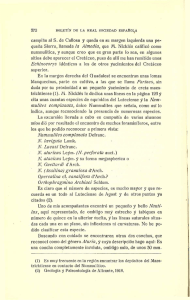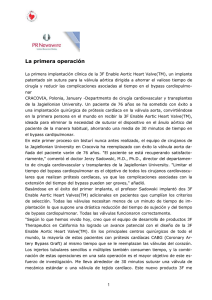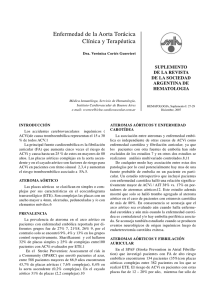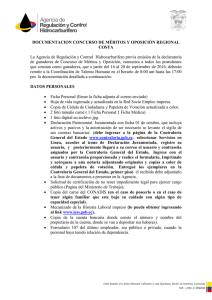Double incomplete aortic arch and Kommerell`s Diverticulum as a
Anuncio
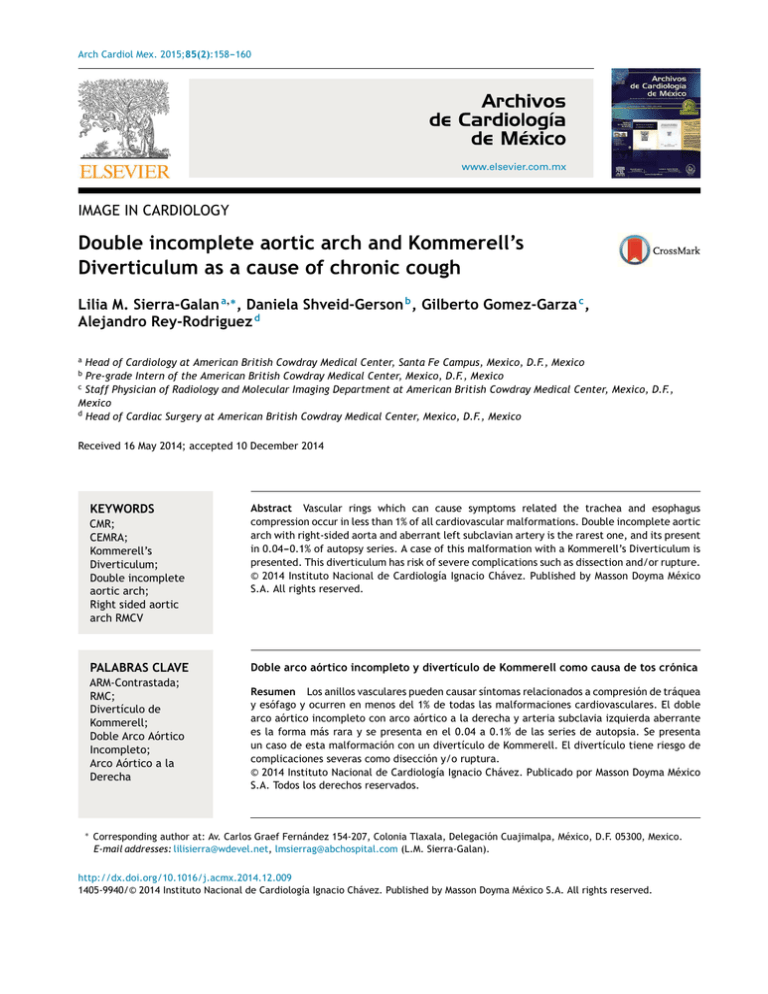
Arch Cardiol Mex. 2015;85(2):158---160 www.elsevier.com.mx IMAGE IN CARDIOLOGY Double incomplete aortic arch and Kommerell’s Diverticulum as a cause of chronic cough Lilia M. Sierra-Galan a,∗ , Daniela Shveid-Gerson b , Gilberto Gomez-Garza c , Alejandro Rey-Rodriguez d a Head of Cardiology at American British Cowdray Medical Center, Santa Fe Campus, Mexico, D.F., Mexico Pre-grade Intern of the American British Cowdray Medical Center, Mexico, D.F., Mexico c Staff Physician of Radiology and Molecular Imaging Department at American British Cowdray Medical Center, Mexico, D.F., Mexico d Head of Cardiac Surgery at American British Cowdray Medical Center, Mexico, D.F., Mexico b Received 16 May 2014; accepted 10 December 2014 KEYWORDS CMR; CEMRA; Kommerell’s Diverticulum; Double incomplete aortic arch; Right sided aortic arch RMCV PALABRAS CLAVE ARM-Contrastada; RMC; Divertículo de Kommerell; Doble Arco Aórtico Incompleto; Arco Aórtico a la Derecha ∗ Abstract Vascular rings which can cause symptoms related the trachea and esophagus compression occur in less than 1% of all cardiovascular malformations. Double incomplete aortic arch with right-sided aorta and aberrant left subclavian artery is the rarest one, and its present in 0.04---0.1% of autopsy series. A case of this malformation with a Kommerell’s Diverticulum is presented. This diverticulum has risk of severe complications such as dissection and/or rupture. © 2014 Instituto Nacional de Cardiología Ignacio Chávez. Published by Masson Doyma México S.A. All rights reserved. Doble arco aórtico incompleto y divertículo de Kommerell como causa de tos crónica Resumen Los anillos vasculares pueden causar síntomas relacionados a compresión de tráquea y esófago y ocurren en menos del 1% de todas las malformaciones cardiovasculares. El doble arco aórtico incompleto con arco aórtico a la derecha y arteria subclavia izquierda aberrante es la forma más rara y se presenta en el 0.04 a 0.1% de las series de autopsia. Se presenta un caso de esta malformación con un divertículo de Kommerell. El divertículo tiene riesgo de complicaciones severas como disección y/o ruptura. © 2014 Instituto Nacional de Cardiología Ignacio Chávez. Publicado por Masson Doyma México S.A. Todos los derechos reservados. Corresponding author at: Av. Carlos Graef Fernández 154-207, Colonia Tlaxala, Delegación Cuajimalpa, México, D.F. 05300, Mexico. E-mail addresses: lilisierra@wdevel.net, lmsierrag@abchospital.com (L.M. Sierra-Galan). http://dx.doi.org/10.1016/j.acmx.2014.12.009 1405-9940/© 2014 Instituto Nacional de Cardiología Ignacio Chávez. Published by Masson Doyma México S.A. All rights reserved. Kommerell’s Diverticulum and double aortic arch 159 right-sided aorta (RSAoA) and aberrant left subclavian artery (ALSA) is the rarest one, and its present in 0.04---0.1% of autopsy series.2 We present a case of a one-year-old boy with chronic cough and difficulty for the feeding progression process, an out-site barium’s swallow reported extrinsic compression of the esophagus. Due to radiation-safety concerns, a CMR was Vascular rings which can cause symptoms related the trachea and esophagus compression occur in less than 1% of all cardiovascular malformations1 and usually associates with others left sided ones, highlighting the importance of a comprehensive approach of the heart and the vascular structures in the same study, such as CMR to plan the surgical approach.1 Double incomplete aortic arch (DIAoA) with A B DIAoA Ao Ao RSAoA Ao Ao KD C Ao DIAoA T RSAoA E Ao Figure 1 CMR of the aorta. SSFP fixed cine image axial view at aortic arch level and just distal (A) shown a double incomplete aortic arch with right-sided aorta and a KD (B). An axial T2-W image showed compression of the trachea (T) and the esophagus (E) by vascular structures (C). CMR, cardiac magnetic resonance; SSFP, steady state free precession; T2-W, T2-weighted; CE-MRA, contrastenhanced magnetic resonance angiography; MIP, maximum intensity projection; 3D VR, 3-dimensional volume rendering; Ao, aorta; DIAoA, double incomplete aortic arch; RSAoA, right sided aortic arch; ALSA, aberrant left subclavian artery; KD, Kommerell’s Diverticulum. A B C RSAoA DIAoA DIAoA ALSA RSAoA KD Figure 2 CMR of the aorta. ALSA originates from the incomplete left aortic arch as shown in the CE-MRA on MIP (A) and 3D VR reconstructions (B). The KD originating from the descending aorta is shown in (B). A coronal SSFP view shows ‘‘V’’ shape of the double incomplete aortic arch (C). CMR, cardiac magnetic resonance; SSFP, steady state free precession; T2-W, T2-weighted; CE-MRA, contrast-enhanced magnetic resonance angiography; MIP, maximum intensity projection; 3D VR, 3-dimensional volume rendering; Ao, aorta; DIAoA, double incomplete aortic arch; RSAoA, right sided aortic arch; ALSA, aberrant left subclavian artery; KD, Kommerell’s Diverticulum. 160 performed; a DIAoA with RSAoA and a Kommerell’s Diverticulum (KD) were seen, which showed compression of the trachea and the esophagus by vascular structures. ALSA originates from the incomplete left aortic arch. The RSAoA develops when the fourth left aortic arch involute and the right one persists.3,4 When an ALSA exists, it can create an aneurysmatic vascular dilatation, known as KD, which can be concomitant to the double aortic arch (DAA).2 The KD represents the persistency of the distal segment of DAA, generally the left one which proximal segment is atretic or disappears.1 There are three KD types described, the second one is the rarest one and it forms when the KD coexists with RSAoA and ALSA (Figs. 1 and 2).3---6 The KD has risk of severe complications such as dissection and/or rupture.7 Ethical responsabilities Data confidentiality. The authors declare that they have followed the protocols of the workplace on the publication of patient data. Right to privacy and informed consent. The authors declare that no patient data appear in this article. Protection of human subjects and animals in research. The authors declare that no experiments were performed on humans or animals for this study. L.M. Sierra-Galan et al. Funding No endorsement of any kind received to conduct this study/article. Conflict of interest The authors declare no conflict of interest. References 1. Calderon-Colmenero J, Muñoz L, Garcia-Montes JA, et al. Diverticulum of Kommerell. Arch Cardiol Mex. 2005;75:451---4. 2. Barranhas AD, Mauricio J, Indiani C, et al. Case report atypical presentation of Kommerell’s diverticulum. Arq Bras Cardiol. 2009;93:88---90. 3. Goodman PC, Jeffrey RB. Angiographic evaluation of the ductus diverticulum. Cardiovasc Interv Radiol. 1982;5:1---4. 4. Shuford WH, Sybers RG. Circumflex retroesophageal right aortic arch simulating mediastinal tumor or dissecting aneurysm. Am J Roentgenol. 1986;146:491---6. 5. Edwards J. Anomalies of the derivatives of the aortic arch system. Med Clin N Am. 1948;32:925---48. 6. Haughton VM, Fellows KE. The cervical aortic arches. Radiology. 1975;114:675---81. 7. Ebner L, Huber A, Christe A. Case report right aortic arch and Kommerell’s diverticulum associated with acute aortic dissection and pericardial tamponade. Acta Radiol Short Rep. 2013;2: 4---6.
